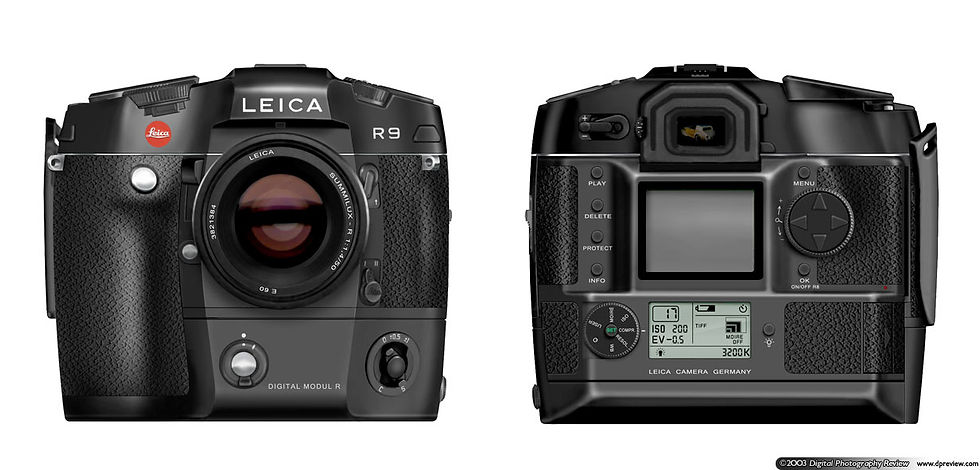Just a few years ago, when DSLRs were the king in low-budget indie productions, it was easy to see the difference between the video quality of these hybrid stills/video cameras and a professional filmmaking tool. Currently, when talking about pure image quality, the differences aren’t always so obvious, and sometimes they’re practically nonexistent.

Leica M cameras :

Leica's M-rangefinder cameras have maintained a consistent feel and appearance over time. Yet, the series has undergone a continuous evolution in terms of capabilities and features since the original M3 was launched in 1954. Find out in this compendium how the various film and digital M-models differ.
Leica R and Leicaflex cameras :

Leica produced single lens reflex cameras for its R-system from 1964 to 2009. New features and capabilities – big and small – were introduced with every new camera model. The release of an autofocus-capable R10 camera was envisaged, but eventually not pursued. The evolution of the system and the differences in camera specifications are highlighted in this compendium.
Nikon DSLR cameras :

Nikon boosts a proud history as a camera and lens producer. It has released more than 50 DSLRs since 1999, many of which work perfectly well with lenses from the film era. The company caters to the full range of photographers – from the casual shooter to the professional. This system overview shows all the different Nikon-DSLRs and their main features grouped by camera-line.
Nikon has developed and maintained several lines of cameras that differ across feature sets and target users:
Pro-line - Professional-oriented, integrated battery grip;
FF-line - Full frame sensor, enthusiast-oriented;
Dxxx-line - APS-C sensor, enthusiast-oriented;
D7xxx-line - APS-C sensor, weather-sealing;
D5xxx-line - APS-C sensor, mid-level series;
D3xxx-line - APS-C sensor, budget-oriented;
Dxx-line - APS-C sensor, pre-2009;
Canon DSLR cameras :

Canon has been the market leader for digital interchangeable cameras and offers models for virtually every purse and every purpose. The company has released more than 50 DSLRs since the early 2000s. This system overview shows the different models grouped into camera lines and makes it possible to easily compare key features and specifications.
Over time, Canon has developed and maintained several lines of cameras that differ across feature sets and target users:
1Ds-line - Professional, integrated battery grip, full frame sensor;
1D-line - Professional, integrated battery grip, APS-H sensor;
5D-line - Professional, full frame sensor;
6D-line - Enthusiast-oriented, full frame sensor;
7D-line - Professional, APS-C sensor;
xxD-line - Enthusiast-oriented, APS-C sensor;
xxxD/Rebel-i-line - Mid-level, APS-C sensor;
xxxxD/Rebel-line - Value-oriented, APS-C sensor;
Four Thirds cameras :

Olympus, Panasonic, and Leica released 18 different FT camera models between 2003 and 2010. Many of these were more compact and more feature-rich than competing APS-C cameras, but the smaller FT-sensor struggled to provide similar image quality. This compendium lists all the FT cameras with their core specifications, so comparisons across models and time are easy to make.
Fujifilm X cameras :

Fujifilm's X-system of cameras has gained many fans among enthusiast photographers since its launch in 2012. The combination of a retro-look with modern technology and comprehensive manual controls has inspired a strong and loyal following. Fujifilm has further developed and differentiated its models over time and this overview details the various model lines and highlights their differences.
Over time, six lines of Fujifilm cameras have emerged that differ across feature sets and target users:
XH-line - DSLR-style, video-centered;
XT-line - DSLR-style, electronic viewfinder;
XPRO-line - Rangefinder-style, hybrid optical/electronic viewfinder;
XE-line - Rangefinder-style, electronic viewfinder;
XA-line - Rangefinder-style, no viewfinder;
XM-line - Rangefinder-style, no viewfinder, compact design;
Olympus MFT cameras :

Olympus was a pioneer of the mirrorless revolution. Since 2009, the company has released a range of heritage-inspired cameras with modern, mirrorless technology that aim to conquer the heards and wallets of different types of photographers. Four distinct camera lines exist: OMD, PEN, PL, and PM. This compendium shows all Olympus Micro Four Thirds cameras with their key specifications and pricing.
In particular, Olympus has developed and maintained four lines of cameras that differ across feature sets and target users:
OMD-line - DSLR style, integrated viewfinder;
PEN-line - Rangefinder style, enthusiast-oriented;
PL-line - Rangefinder style, no viewfinder;
PM-line - Rangefinder style, no viewfinder, very compact;
Panasonic MFT cameras :

When the Panasonic Lumix G1 was released as a mirrorless interchangeable lens camera in September 2008, it established the basis for what over time became the Micro Four Thirds system. Since then Panasonic has build up several distinct MFT camera lines: G, GH, GX, GF and GM. This overview article lists all of Panasonic's MFT cameras with their headline specs in chronological order.
In particular, Panasonic has developed and maintained five lines of cameras that differ across feature sets and target users:
G-line - DSLR style, still imaging centered;
GH-line - DSLR style, video centered;
GX-line - Rangefinder style, enthusiast-oriented;
GF-line - Rangefinder style, no viewfinder;
GM-line - Rangefinder style, extremely compact
Sony E-Mount cameras :

Sony has led the development of mirrorless APS-C and full-frame cameras and has steered up the photography industry with its innovation pace and short product cycle. The company's differentiated lines of full-frame models has been a particular challenge for Canon and Nikon. This compendium lists all of Sony's E and FE-mount cameras along with their main specifications.
There are several lines of Sony cameras that differ across feature sets and target users:
A9-line - DSLR style, full-frame sensor, sports-oriented;
A7R-line - DSLR style, full-frame sensor, high resolution;
A7S-line - DSLR style, full-frame sensor, video-oriented;
A7-line - DSLR style, full-frame sensor, enthusiast-oriented;
A6000-line - Rangefinder-style, APS-C sensor, enthusiast-oriented;
A5000-line - Rangefinder-style, APS-C sensor, value-oriented;
A3000-line - DSLR style, APS-C sensor, value-oriented;
NEX-line - Rangefinder-style, APS-C sensor, pre-2014;
